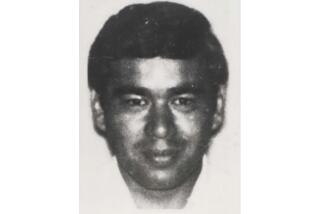‘Cold-Case’ Unit Hot on Trail in ’83 Killing
- Share via
Nearly 20 years have passed since St. Patrick’s Day 1983, when Elaine Graham dropped off her 2-year-old daughter at a baby-sitter’s home in Northridge, drove off in her faded yellow Volkswagen Bug and was never seen alive again.
The Sherman Oaks nurse’s skeletal remains were discovered scattered on a hillside in the rugged Brown’s Canyon area of Chatsworth eight months later. Soon after, the Los Angeles County medical examiner determined that the 29-year-old wife and mother had been fatally stabbed.
Los Angeles police thought they had cracked the case a month later when a man carrying a bloodied, double-edged, military-style survival knife was arrested on an armed robbery charge. He had been in nearby Northridge when Graham disappeared.
But prosecutors wanted a more conclusive link, and like thousands of other “cold cases,” the Graham killing was put on the back burner in favor of more immediate investigations.
Now, a group of Los Angeles police detectives solely dedicated to solving old murders say they are close to an arrest in the case, which would be the first for the unit formed in late 2001. While the case has languished, investigators said the passage of time -- and the development of DNA technology -- could actually help unlock the 2-decades-old mystery.
Just last week, the cold-case unit of the Los Angeles County Sheriff’s Department, the county’s largest law enforcement agency, arrested a South Carolina man in the 45-year-old slayings of two El Segundo police officers. Detectives said they matched a fingerprint from the crime scene with the 69-year-old suspect.
Both units are less than 3 years old. Nationally, units focusing on old unsolved cases have become increasingly active, due in part to advances in forensic technology.
In the Graham case, forensic test results of the blood found on the hilt of a knife so far are consistent with the slain woman’s blood.
The Los Angeles Police Department also has contracted with the National Law Enforcement and Corrections Technology Center in El Segundo to test the physical characteristics of the knife against the wound track in Graham’s vertebra.
“We expect that the wound discovered in the skeletal remains is consistent with this knife,” said veteran LAPD Det. Rick Jackson, who is working the case with partner Tim Marcia. “Let’s just say the knife has unique specifications.”
A third of all murders in the city of Los Angeles typically go unsolved in a given year, leaving a total of 8,300 cold-case slayings dating back four decades.
To thin that backlog, the LAPD formed the cold-case unit.
The seven detectives with the unit have focused the majority of their efforts on revisiting murders that occurred between 1960 and 1997, and picking which to pursue again, based on the presence of such evidence as DNA, fingerprints and ballistics, as well as the knowledge of suspects who were identified but not prosecuted.
DNA and the alleged murder weapon are enough to build a strong physical case against Graham’s killer, detectives said. They also have solid circumstantial evidence based on previous detective work.
A native of Waterbury, Conn., Graham moved to Los Angeles in 1976 where she met Dr. Stephen Graham, then an intern at Cedars-Sinai Medical Center. The couple married in 1979, had a daughter two years later and moved to Sherman Oaks.
The short-haired and athletic Graham was working part time at Cedars-Sinai and taking English classes at Cal State Northridge. Authorities believe she encountered her killer near campus.
Detectives said Monday that they are not prepared to name the suspect. According to a 1984 account in The Times, the lead suspect at the time was Edmond Jay Marr, who was discharged from the Army in Barstow on March 16, 1983, and was at his mother’s Northridge home the day Graham vanished.
Late in the afternoon of March 17, 1983, Marr showed up at his sister’s Orange County home, which is within walking distance of the Santa Ana shopping mall where Graham’s car was found abandoned.
According to police records, Marr had a history of violence and drug use. He was convicted of an armed robbery in Orange County in 1983 and served time in prison.
Investigators said in previous news accounts that Marr frequented the remote Brown’s Canyon area, where Graham’s body was discovered.
As technology advances over time, so too can relationships and allegiances change, detectives said.
“Sometimes, people with incriminating information who were not willing to talk back then are motivated to provide us with information today,” Jackson said.
More to Read
Sign up for Essential California
The most important California stories and recommendations in your inbox every morning.
You may occasionally receive promotional content from the Los Angeles Times.












